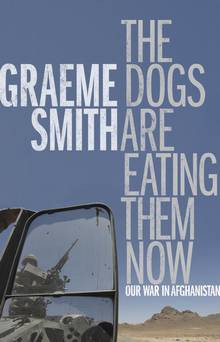
Title The Dogs Are Eating Them Now: Our War in Afghanistan
Author Graeme Smith
Genre nonFiction
Publisher Knopf Canada
Pages 320
During the height of Canada’s combat deployment in southern Afghanistan, the young correspondent Graeme Smith stood out in the press corps because of his seniority in the city of Kandahar. Many journalists dropped in briefly, grabbed a story or two, and flew back to the safety of Kabul or the five-star luxuries of Dubai. But Smith kept coming back. He lived for long periods outside the safety of military bases to report for this newspaper from 2006 to 2009.
His book on Canada’s war in Afghanistan, The Dogs Are Eating Them Now, is a chronicle of disillusionment. The war, he writes, “broke my heart”: like many Canadians, he saw our mission there as fundamentally humanitarian and gave it a reasonably good shot at success. But his repeated encounters with reality quickly disabused him. The mission never really entered a humanitarian phase, and the fighting obeyed certain rhythms but never abated. Taliban always regrouped and returned, no matter how resounding their defeats in battle. And the daily butcher’s bill of suicide attacks and ambushes eventually demoralized Smith, particularly on the occasions when he had to pick the charred flesh of suicide bombers from the treads of his shoes.
This experience would weary the psyche of any reporter, in addition to making him consider switching to flat soles. Smith persevered in Kandahar for longer than others, and he produced vivid newspaper reporting until the end. But his book is something different and more personally revealing, and its most valuable and interesting elements are what you don’t get in those newspaper dispatches – descriptions of the difficulties of reporting, safety protocols when navigating the city, small anecdotes that illustrate the alienation between Canada and Afghanistan, and the hopelessness of efforts by the former to help the latter.
Kandahar was then, as now, one of the most difficult places in the world for a reporter to work. Security concerns forced Smith to don shalwar kameez, the long Afghan shirt and billowy pajama bottoms, to report. That dress posed problems when entering North Atlantic Treaty Organization installations; he found that yelling the names of the base’s fast-food joints (“Burger King! Pizza Hut!”) helped to convince the trigger-happy guards at the gate that he wasn’t an Afghan.
To deprive assassins of a stationary target, Smith met sources in the back of his driver’s car, and interviewed them while being driven around the city. When he set up an office, a den of security for frank interviews with skittish sources, unidentified attackers showed up to ransack the place and beat his cook.
On the substance of the Canadian mission in Afghanistan, Smith has little positive to report. Policies focused on poppy eradication, a dubious goal in a country where many farmers had few alternative crops. He remains personally saddened and aggrieved about the treatment of detainees, whom Canadian Forces transferred to Afghan authorities, knowing full well that the Afghans would torture them. In one poignantly absurd case, an Afghan detainee tells him how a Canadian soldier tenderly shielded the man’s head from smacking the steel sides of a vehicle as it bumped along a road – even though that vehicle was delivering the man to Afghan police who would beat him anyway. The Afghans puzzle over ironies like these. Smith hires a researcher to interview insurgents for him, and asks them to give their best guess about where, or what, Canada is. No one knows. “An old, destroyed city,” ventures one uncertainly, in a forehead-smacking moment that should inspire doubt about whether the divide between insurgent and occupier is one that can ever be closed.
Smith’s book is at once honest, smart, and only a little unsatisfying because of a lack of analysis. Smith visits Quetta, the Pakistani city long assumed to be the seat of much of the Taliban leadership, but doesn’t add much to our knowledge of Pakistan’s significant role in the war, particularly in Kandahar. He extracts a few general observations about the Taliban – that air strikes have pushed many of them to attack Canadians, that they are motivated as much by tribal grudges as by religion, and that they are willing to negotiate under the right circumstances. None of these observations is original, but none is wrong either, and in any case the great value of the book is its depiction of three years of fighting in Kandahar rather than prescriptions for three more. After all, as Smith says, the war is lost already, and it will be a long time before Canada has the appetite to take part in another one.
Perhaps because it attempts to fit several years in a few hundred pages, the narrative is desultory (in this way resembling the Canadian mission itself). Smith left Kandahar in 2009, when a story on the drug-crime-corruption nexus threatened his life there – and made reporting a little more fraught for Afghanistan’s other Canadian reporters named Graeme, who could be confused for him (not that I am bitter). He now works for a think-tank in Kabul. For those interested in the succession of crimes and tragedies that marked Canada’s time in charge of Kandahar, his book should be compulsory reading.
Graeme Wood has reported from Afghanistan for The New Yorker, The Atlantic and The Walrus.

